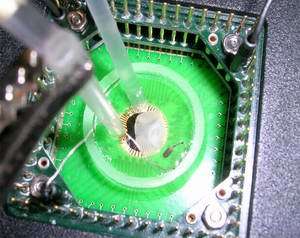Brain 'avalanches' may help store memories

Meeting a friend you haven't seen in years brings on a sudden surge of pleasant memories. You might even call it an avalanche.
Recent studies suggest that avalanches in your brain could actually help you to store memories. Last year, scientists at the National Institutes of Health placed slices of rat brain tissue on a microelectrode array and found that the brain cells activated each other in cascades called "neuronal avalanches."
New computer models now suggest that these brain avalanches may be optimal for information storage. If so, certain neurochemical treatments might someday improve life for people with memory problems. A report of this work will be published Feb. 4 in the journal Physical Review Letters.
Image: A slice of rat brain tissue on a microelectrode array shows that brain cells activate each other in "neuronal avalanches."
"When most people think of an avalanche, they imagine something huge," said biophysicist John Beggs, now a professor in the Biocomplexity Institute at Indiana University Bloomington, who helped perform the NIH experiments. "But avalanches come in all sizes, and the smaller ones are most common. That's just what we found in the brain cells."
An avalanche roaring down a mountainside may seem to be wildly out of control, but actually it is governed by certain equations. These same equations also govern such seemingly unrelated events as forest fires and earthquakes -- as well as some neural activity in the brain, Beggs said. All are examples of phenomena that can be studied with the new science of complexity, which deals with all kinds of complex systems ranging from living cells to national economies.
Biocomplexity is a cross-disciplinary field involving physics, chemistry, computer science, mathematics and the life sciences. A description of the IU Biocomplexity Institute, headquartered in IU Bloomington's Department of Physics, is available at www.indiana.edu/~iufcs/issue7/solving.shtml.
To find out the possible benefits of brain avalanches, Beggs and IU senior Clay Haldeman simulated the spreading activity of brain cells in a computer model. When the activity was tuned to mimic the avalanches seen in brain tissue, a large number of stable activity patterns appeared. Stable activity patterns are thought to be important for memory, since they have been recorded in the brains of monkeys and rats after they perform memory tasks, Beggs said.
"The fact that the most stable activity patterns appeared when the network of brain cells was also producing avalanches hints that the brain may actually use avalanches to store information," Beggs said.
"This work might ultimately help human memory," he explained. "If our computer simulations apply to networks of human brain cells, then it would be desirable to have your brain in a state where it naturally produces avalanches. In the laboratory, we can apply neurochemicals to defective networks of rat brain cells, gently easing them into a state where avalanches occur. These chemicals suggest treatments that might someday improve information storage in people with memory problems."
Source: Indiana University

















